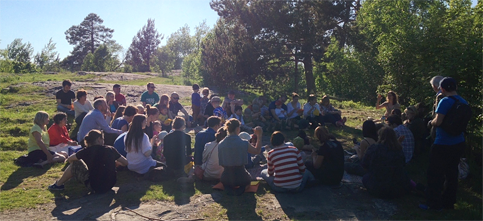
Finland consistently scores at or near the top in worldwide education surveys. The implications for the US have been discussed widely in US media, including prominent articles in The Atlantic, the New York Times, and The Washington Post.
I’m quite interested in this. Born in Finland, I am a US resident and went to public school in both countries. My father is Professor of Education at the University of Helsinki, my own graduate studies were in sociology and I am currently homeschooling my children here in the US.
Although homeschooling is legal it is still rare in Finland. Most Finns are happy with public education and don’t see the need to homeschool. Moreover, private education is virtually nonexistent.
I’ve just finished reading Pasi Sahlberg’s 2011 book Finnish Lessons: What Can the World Learn from Educational Change in Finland and it occurred to me that the reason for Finland’s success in public education might be that it strikingly resembles homeschooling.
Here are my notes from the book.
- Finland is small – but as a unit of educational reform 5.3 million is comparable to many states and provinces in other countries (including US states, which have a lot of say in designing their education systems)
- In international educational surveys, Finland went from being an average performer to a top performer in just a few decades. At the same time inequality between students, which started out being considerable, was reduced to a minimum.
- Finland is homogenous in terms of language and culture – but it is the most rapidly diversifying European country, and has managed to improve even as it has diversified
Enablers
- Not only small classes but also small schools
- Motivated teachers who get a great education and a lot of autonomy
- Absence of testing and audits keeps school stress-free
- Shorter days and less homework mean there’s more energy left to be creative
- Children learn to read early regardless of school; their literacy provides a basis for other learning
- Normalcy of special ed: roughly half receive it at some point
- Other people really value teachers
- Well designed spaces and nutritious warm meals
- High social cohesion and trust. On average, a Finn belongs to three clubs or associations
Challenges
- Children are spending more and more time on their devices; they use them to learn different things at different speeds
- Children find themselves in bigger schools; small schools are disappearing
- Devices are also changing how children spend time together face to face
- Boys are no longer reading as much for pleasure (no data on girls?)
- Older children increasingly feel the lessons at school are irrelevant
Sahlberg’s reader will conclude that a great school is small, led by highly educated teachers who are free to do things their way, has short days and issues little homework. It relies on parents and other people who help the children learn to read early. When a child has difficulty learning something – which happens to many at some point – they get help from a specialized teacher without being stigmatized. Plus, everybody there benefits from well-designed spaces and good food.
To Sahlberg the key challenge now is personal media. Because children spend so much time on their screens, teachers find they are harder to reach. They read fewer books on their own and their learning is out of synch with their peers. Hence, more effort is required from teachers to engage each individual student. But schools are getting larger and as the kids get older, they become even less engaged and more dissatisfied. They no longer see any reason to be in class. They use their devices to access information and to communicate.
Sahlberg’s answer, which he calls the Big Dream, is school as a safe community where children are free to pursue their interests, learn more diverse things, and discover their unique talents. In the future he paints, classroom-based teaching gives way to customized, activity-based learning:
Rather than continue thinking of future schooling in terms of subjects and time allocations to them, the time is right now to make a bold move and rethink the organization of time in schools. This would mean having less time allocated to conventional subjects, such as mother tongue, mathematics, and science, and more time for integrated themes, projects, and activities.
He continues:
This would also mean a shift from common curriculum-baed teaching to individual learning-plan-based education. This would lead to extended time for all students to spend engaged in personally meaningful workshops, projects, and the arts.
Sounds a lot like homeschooling.